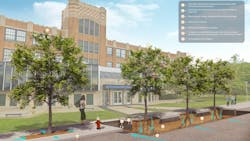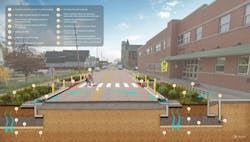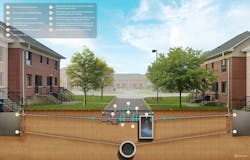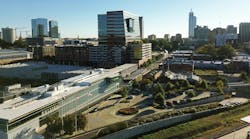Protecting Buffalo’s freshwater future
Key Highlights
- Buffalo's aging combined sewer system can overflow during heavy rain, releasing pollutants into waterways and harming ecosystems.
- The Long-Term Control Plan (LTCP) aims to reduce sewer overflows from 37 to 9 annually by 2040 through green infrastructure investments.
- The Rain Check Program has advanced green infrastructure projects like green streets, rain barrels, and park improvements to manage stormwater locally.
Freshwater is a limited resource. It is crucial for sustaining life and a vital asset for the residents and businesses of Buffalo, New York. But Buffalo’s water resources and neighborhoods are limited by its aging combined sewer system. This system channels both stormwater and sanitary sewage through a single pipe.
While this system works well during dry weather or light precipitation, it can be overwhelmed during heavy rain or snow melt. When this happens, untreated sewage and stormwater can back up into basements and streets or overflow into local waterways. Combined sewer overflows (CSOs) can transport pathogens, nutrients, heavy metals and toxic substances into rivers, lakes and coastal waters, posing serious risks to both drinking water safety and recreation use.
To prevent widespread flooding and infrastructure damage, Buffalo’s system includes 53 combined sewer outfalls that discharge excess flow into rivers and tributaries. These overflows contribute to beach closures, algae blooms and reduced oxygen levels in aquatic ecosystems. This degrades water quality and harms aquatic life and public health. With approximately 20% of the world’s freshwater flowing past Buffalo via the Great Lakes, protecting this resource is not just a local concern, it is a global responsibility.
A long-term vision for cleaner water
Since 1935, the Buffalo Sewer Authority (BSA) has prioritized environmental protection and public health. To address the challenges of its aging infrastructure, BSA has worked with the community and local, state and federal stakeholders to develop a Long-Term Control Plan (LTCP). The LTCP documents Buffalo’s combined sewer system deficiencies and provides a roadmap for correction, in full compliance with regulatory guidelines.
BSA’s LTCP focuses on using a comprehensive approach to improve water quality — placing green infrastructure at the heart of its stormwater management strategy. By 2040, BSA aims to manage nearly 570 acres of impervious surfaces with green infrastructure and reduce overflow events from 37 times per year to 9.
Green infrastructure emulates natural processes to capture and treat stormwater where it falls. These systems slow runoff. This gives wastewater treatment plants more time to process incoming flows and, in turn, reduces the volume of diluted wastewater entering waterways.
Rain check: Buffalo’s green infrastructure program
In 2015, BSA launched the Rain Check Program, a dedicated green infrastructure program designed to advance the goals outlined in the LTCP. The program began with Rain Check 1.0, which introduced Buffalo’s first generation of green infrastructure. This phase focused on four key strategies for managing stormwater: green streets, green parking lots, vacant lot restoration, and rain barrel installation.
Building on that foundation, BSA introduced Rain Check 2.0 in 2018. This second phase targets six priority sewer sheds across Buffalo. BSA selected these areas for their potential to enhance water quality, public health and environmental justice. These areas also have the potential to reduce combined sewer overflow events, flooding, and impervious surface coverage.
In June 2021, BSA secured a $54 million Environmental Impact Bond (EIB), the largest bond issued in the country to date, to fund green infrastructure in the six targeted combined sewer areas identified under the Rain Check 2.0 Program. The EIB mandates management of over 200 acres of impervious area with green infrastructure practices, with performance-based redemption options available starting in June 2028.
Pivoting with purpose: A new strategy
In 2022, BSA launched the Smart Sewer and Water Program to integrate green and gray infrastructure in citywide projects. This initiative focused on amplifying the impact of green infrastructure through partnerships with other stakeholders on large-scale, citywide projects. The goal was to create improved multimodal corridors that supported both pedestrian and vehicular traffic, while integrating green and gray infrastructure solutions, especially in historically underserved and environmentally challenged neighborhoods.
By 2024, however, BSA learned that their partner organizations could no longer fund the comprehensive project approach. To meet the requirements of the EIB, BSA pivoted with support from Stantec to identify new implementation opportunities.
The team launched a stakeholder outreach effort to find new opportunities for green infrastructure implementation. Throughout this process, organizations including the Buffalo Municipal Housing Authority, Buffalo Public Schools, and the Department of Public Works stepped forward. They expressed interest in incorporating green infrastructure practices on the properties they manage.
Data-driven siting and design
Stantec utilized the geospatial platform ArcGIS and spatial data to identify and evaluate potential sites. The team applied siting constraints, including:
- Economic viability (e.g., minimum impervious area capture)
- Spatial data (e.g. utility locations, property boundaries, mature tree canopy, drainage areas, soil conditions)
- 311 call records
- Stakeholder feedback
Stantec’s team assessed each site for environmental and social benefits, technical feasibility, treatment efficiency, constructability and cost.
By the end of 2024, Stantec and BSA identified over 550 green infrastructure systems, capable of managing more than 200 acres of impervious surface. Stantec then worked with BSA to group these systems into 14 design packages that span right-of-way improvements, nine public parks, 19 public schools, and two Buffalo Municipal Housing Authority sites — Ferry Grider and Kenfield Langfield.
Funding the future
Despite this progress, BSA faced a $30 million dollar gap to meet the EIB goals. To close this gap, BSA pursued grants with a focus on stormwater improvements and community benefits. In October 2024, BSA was awarded an $8.75 million grant through the EFC Green Resiliency Grant (GRG) program to support the installation of green infrastructure practices within nine public parks. The GRG requires the management of at least 100,000 cubic feet of runoff annually.
BSA and Stantec are actively working together to pursue additional grant opportunities to close the funding gap and to supplement and extend the reach of the program.
Community at the core
Rain Check 2.0 emphasizes implementation of green infrastructure on public rights-of-way and on city-owned properties. This reinforces the program’s broader community impact. Educational outreach is a key component, with workshops, seminars and public meetings planned to raise awareness about green infrastructure and stormwater management.
These efforts aim to revitalize underinvested neighborhoods by upgrading sidewalks, adding ADA-compliant crossings, and enhancing public spaces. Community workshops will also invite residents to provide feedback, such as their preference among native tree species in new installations. BSA is committed to keeping the public informed throughout the project’s lifecycle.
Looking ahead
While the scale of Buffalo’s combined sewer overflow challenge may seem daunting, BSA has prepared a step-by-step, comprehensive and strategic mitigation strategy. BSA’s community-driven approach offers a replicable model for other cities.
Design work is currently underway. Construction is expected to begin in spring 2026 and conclude by summer 2028. This milestone will mark a major step towards a more sustainable, resilient and equitable Buffalo, where clean water and green spaces are accessible to all. Through its systemic and community-driven approach, BSA is confident it will meet its goals and set a national example for urban stormwater management.
About the Author
Rosaleen Nogle
Rosaleen Nogle is the principal sanitary engineer at the Buffalo Sewer Authority.
Stephanie Alessandrini
Stephanie Alessandrini is a water project manager from Stantec, based in the firm’s office in Albany, New York.




